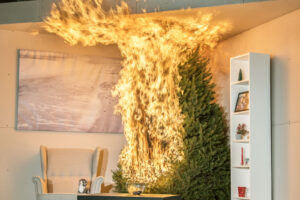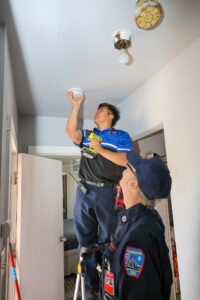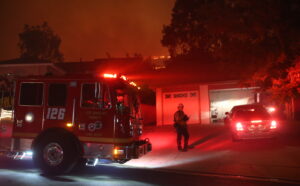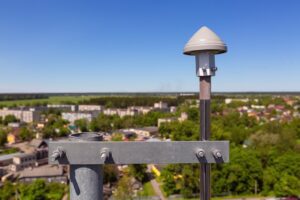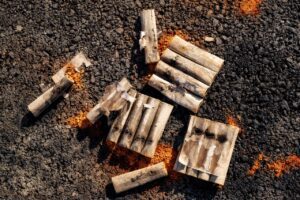I met Arnett Hartsfield on three occasions. I listened to him speak on perhaps ten different days – at events, memorials, and at his old fire station in Los Angeles. His story is important to not only the Los Angeles Fire Department, but to the fire service, and indeed to the fabric of our society. I will never forget him, and he is one of the most important people I’ve ever met.
Nobody knows for certain when Arnett Hartsfield began calling himself “the Rookie.” It’s a term used for probationary firefighters – or in Mr. Hartsfield’s day, firemen. Officially, the probationary term was dropped after passing that one year period of initial training and experience. Socially, it was dropped when the next rookie was assigned to the same station – or the rookie transferred to a new house.
As a child, Arnett was a “westsider,” growing up in a progressive neighborhood, where even as a minority, he was welcomed amongst his mostly white childhood friends. He was the product of an interracial family – his grandfather was an Irishman from Belfast.
He became a Los Angeles fireman in 1940, just before America entered the second world war. As an African American, Mr. Hartsfield was entering a profession long dominated by whites, and where black men were not welcome.
Assigned to all-black Fire Station 30, Rookie Fireman Hartsfield was working when Pearl Harbor was attacked in December of 1941. Because he was a graduate of ROTC at Manual Arts High School, he was soon called up for military service, and was commissioned as an Army infantry Lieutenant. It was there that he faced segregation on a national level; assigned to a black-only supply unit and sent to the pacific theater – to load and unload ships of their cargos.
After the war, he returned to Los Angeles and the LAFD. He returned to Fire Station 30 and his peers – all black, and no officers above the rank of Captain. It was a frustrating time for someone with a college education, military experience as a commissioned officer, and most importantly, someone who had grown up not knowing the hell that was segregation.
Times were on the verge of change, but in many parts of the country, the idea of integration was a dangerous and unpredictable topic. In Los Angeles, the Fire Department’s Chief Engineer, John Adlerson was considered an innovator in the fire service, but equality among his firemen was not at the top of his list. He was an intelligent, but stubborn and traditionally motivated individual, and he believed in segregation.
In 1953, court rulings and outspoken individuals began to open the public’s eyes to the idea that segregation was discriminatory. In 1954, the U.S. Supreme Court declared school segregation unconstitutional, and the City Fire Commission ordered Chief Engineer Alderson to study desegregation and report back to the commission. This back and forth political hot potato continued, and as the heat increased politically, it turned into a furnace for black firemen in the field.
Black firemen began to be transferred to stations previously occupied exclusively by whites. It was a dangerous period of time, with unspeakable acts and hazing delivered against the single black fireman in each station. The transfers were mainly to stations in Battalion 8 and were referred to as “hate houses,” or “punishment houses.”
While Mr. Hartsfield was more fortunate than others, he still ate alone, and prepared his food with his own pots and pans. He showered alone. He performed “rookie” tasks, polishing poles, scrubbing toilets, and laying hose. He mingled with whites only when they were on scene, fighting fire.
Former Lieutenant and Rookie Hartsfield decided he wouldn’t tolerate the unequal and ignorant treatment he and his black comrades received. What’s so important is how he went about pushing for change — and how his success resonates even today.
Mr. Hartsfield had developed a new plan for his life and the opportunity he felt presented with. He enrolled at USC, to earn his second degree: in law. He dedicated all of his off duty time to his education (and his family), using his GI bill to help pay his way. Although it was a struggle, the Rookie graduated with a law degree in 1955. He was the first person in his family to graduate high school, and now he was on the verge of becoming an attorney. Now equipped with both experience and two college degrees, the Rookie went to work.
He began by writing and filing multiple complaints with the Civil Service Commission, pushing the LAFD to properly integrate its ranks. Simultaneously, Mr. Hartsfield recognized the importance of a well educated and supported collective – and he began organizing other black firemen. Working with about 30 other black firemen, an organization called The Stentorians was formed. Stentorian, an evolution of the Greek work “stentor,” which means powerful voice would advocate and protect black (and any discriminated against) fireman in the face of racism.
Due to violence in multiple stations, blacks were being sent back to their segregated fire stations, as Chief Alderson claimed the LAFD would not, “participate in a social experiment.” The Stentorians began 24 hour patrols of Fire Station 10, where one black fireman kept a gun on his person, so afraid was he for his safety.
The City Council, the LA Mayor, Fire Commission and Chief Engineer Alderson continued their cat and mouse charade into the fall of 1955. After a repeated demand by the Commission to integrate, Chief Alderson refused and was suspended for insubordination. The move by the commission was pure politics, as Alderson had already announced his retirement.
In January of 1956, William L. Miller was appointed as Chief Engineer for the LAFD. The issue of integration was at the top of his list. Chief Miller found eight white firefighters who were unopposed to integration, and with help from the Rookie, eight black firemen from stations 14 and 30 and combined them into an integrated fire company at Fire Station 7. Miller called it an experiment, but it worked. By the following September, all of the city’s fire stations were integrated.
In 1961, upon reaching 20 years of service, Mr. Hartsfield retired from the Los Angeles Fire Department. His last assignment was Fire Station 45. He had worked long enough to earn a pension, but his efforts towards equality at work for all people didn’t end with his retirement. He was focused on teaching people that a future based on equality wouldn’t be possible without remembering the past.
Mr. Hartsfield became a professor of Ethnic Studies at Cal State Los Angeles. When his UCLA classmate Tom Bradley was elected as the first black mayor of Los Angeles, the Rookie earned a position as a Civil Service Commissioner. He also wrote a book, “The Old Stentorians,” a history of the LAFD’s integration process.
In 1972, the LAFD was still 95% white. The Rookie and Stentorians continued to work towards better working conditions, and would collaborate on getting “the story” to receptive reporters, so their story would be at least shared via the media. The U.S. Justic Department brought suit against the City of Los Angeles, accusing it of discrimination in its recruiting, hiring, and promotional policies. The city settled the case two years later, acknowledging the importance of hiring all minorities, including not only blacks, but Latinos and Asians as well.
In 1997, Mr. Hartsfield saw an opportunity to turn his once segregated and no longer in-service fire station into a museum. As with most things in his life, making the dream come true was a challenge. “What are you trying to do, build a monument to segregation?” he was asked. Undeterred, the Rookie pushed forward, and with help from the Stentorians and others, old Fire Station 30 was transformed into the African American Firefighter Museum.
While officially serving as the organization’s historian. Mr. Hartsfield unofficially was a mentor to youth in the community, to those African American firefighters eager to promote, and to the ongoing improvement of relations and equality. Whenever a new member of the Stentorians would show up at Old 30s, Mr. Hartsfield would walk up, the ever present cup of coffee in his hand, and say, “us rookies need to stick together.” It was a perfect opening line, and the list of black Los Angeles Fire Department Officers is almost as long as the total hiring list was when the Rookie showed up for his first assignment in 1940.
Throughout his life, the Rookie never lost his temper or enacted revenge for the discriminatory challenges he faced. His legacy has been to teach, to advise on positive engagement, and to build relationships. His leadership is a role model for anyone to follow – that true leaders do not need stripes, bars, bugles, or titles. Leadership comes from within, and involves listening, watching, and learning. From that, engaging your fellow human beings to lead productive lives will spill over into everything you do.
On any given Saturday, Mr. Hartsfield could be found in Old 30s former dormitory, sharing stories and photographs from the bad old days, and putting a positive spin on every incident, every experience. His memory was remarkable, and he could share details of nearly every black fireman that every served the LAFD. He continued to provide guidance to young men looking for direction, to active black and minority firefighters on being better as a person, an ambassador for equality, and a firefighter.
 The struggle he endured might have been more palatable if he knew when he started how his work and those who collaborated with him would turn out. “If I could have looked forward to today and all the advances,” he said, “I didn’t dare to hope that it would change during my lifetime.”
The struggle he endured might have been more palatable if he knew when he started how his work and those who collaborated with him would turn out. “If I could have looked forward to today and all the advances,” he said, “I didn’t dare to hope that it would change during my lifetime.”
In 2010, The Los Angeles Fire Department honored the work of the Mr. Hartsfield, and the Department’s first black Fire Chief Doug Barry presented him with a Lifetime Achievement Award, a first for the LAFD. As he was helped to the podium, the audience rose to their feet, applauding the man who tirelessly worked for equality. The Rookie.
Arnett Harsfield passed away on 31 October, 2014. His funeral service at the Crenshaw Christian Center was a standing only affair. Thanks in part to his efforts, he lived to see not only the first African American elected to be the Mayor of Los Angeles, but the first Black LAFD Fire Chief, Doug Barry be appointed in 2007. Since then, there have been three black LAFD fire chiefs, and the first Latino Fire Chief, Ralph Terrazas. The current LA County Fire Chief Daryl Osby is also an African American. The Rookie also lived to see the election of black members of the LA City Council, two black secretaries of state, and a black President of the United States. Not bad for someone who was the first in his family to graduate high school.
To learn more about The Rookie, visit the African American Firefighter Museum in Los Angeles.



